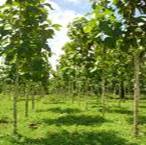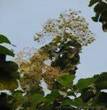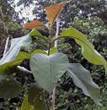| Kingdom | Plantae |
| Unranked | Angiosperms |
| Unranked | Eudicots |
| Order | Sapindales |
| Family | Sapindaceae |
| Genus | Acer |
| Species | A. pseudoplatanus |
| Binomial name | Acer pseudoplatanus |
Other Common Names:
The other common names for the teak tree are Bankok Teak, Indian-Oak, Deleg, Jati and Kulidawa.
History
Teak is a well known for its high grade timber. Although it is known less for its medicinal properties and uses its different plant parts are in use as medicine since generations. It is believed teak was introduced to Java 400-600 years from India.

Description
A large deciduous tree which, under favourable conditions, may reach a height of 30-40 m. In dry habitats growth becomes more stunted and branching more widespread and bushy. On good sites, clear boles of 15-20 m or more can usually be obtained, as lower branches are shaded out. Fluting and buttresses are often found at the base of older trees. The bark is thick, grey or light greyish-brown. The leaves are large, 25-50 cm long and 15-35 cm wide, opposite, elliptic or obovate, the underside grey and densely covered with red glandulous hairs.


Range
The area of natural distribution covers the Indian subcontinent, Myanmar, Thailand and the western part of Laos. Northern limit is latitude 25°N in Myanmar and southern limit 9°N in India. Teak's longitudinal limits are 70°-100°E.
Habitat
Their most suitable soil is deep, well-drained, fertile alluvial-colluvial soil with a pH of 6.5-8 and a relatively high calcium and phosphorous content. The quality of growth, however, depends on the depth, drainage, moisture status and the fertility of the soil. Teak does not tolerate waterlogging or infertile lateritic soils.
Cultivation
The general practice is to use fruits stored for a year after soaking them in water for 24 hours. Fruit that has lain dormant in the ground for 30 to 40 years has been known to germinate abundantly. If it is necessary to use fruits from the same year, they should be subjected to alternate wetting then drying for 24 hours each for 14 days. Soaking the fruit for 48 hours in running water before sowing is the best treatment for hastening germination. Another method is to char (or half burn) the fruits by covering them with a thin layer of grass and lighting it. The germination rate is low, usually less than 50%, but sometimes up to 80%. Germination usually starts after 10 days but may take 2 to 3 months. Seedlings exhibit epigeal germination. Although teak demands strong light, it prefers slight shading during the seedling stage. Then the rootstock is dug up, the stem cut off, and the stump planted into the field. The rooting time of cutting is 8 to 15 days, and the survival rate of rooted stock is 90-100%. Shoots can grow to 3 m in 2 years. Tissue cultures have been perfected for T. grandis. It is possible to produce 500 plants from a single bud of a mature tree or 3000 plants from a seedling in a year. Tissue-cultured plants possess better growth than seed-grown plants.
Flowering Season
Teak normally starts to flower 6-8 years after planting. Flowering takes place in the rainy season, starting about one month after the first rains. Teak usually flowers every year, but with large variation in intensity between years.
Pests and Diseases
The main attack on the stems is by the insect Calothermes tectonae. At first sign of attack, trees should be felled and burned, because no effective insecticide is known. Termites such as Neotermes tectonae may damage the trees, although many provenances show a high resistance. Seeds can be infested by larvae of Lepidoptera and Coleoptera (longhorn beetles). A bacterial wilt caused by Pseudomonas solanacearum often attacks 6-month to 2-year-old seedlings. Fungi such as Corticium salmonicolor can cause disease. Crowns are often infested by semi-parasitic mistletoes, such as Loranthus spp. and Dendrophthoe falcata, which cause severe retardation; lopping affected branches controls them.
Parts Used

Most of the parts of the teak tree are used for its commercial and medicinal purposes.
Medicinal Applications


• Wood is acrid, cooling, laxative, sedative to gravid uterus and useful in treatment of piles, leucoderma and dysentery.
• Flowers are acrid, bitter and dry and useful in bronchitis, biliousness, urinary discharges etc.
• Roots are useful in treatment of urinary system related troubles. According to Unani system of medicine, the oil from flower is hair promoter and useful in scabies.
• Wood is good for headache, biliousness, burning sensation and pain and liver related troubles.
• It allays thirst and possess anthelmintic and expectorant properties.
• The charred wood soaked in poppy juice and made into a paste has been used to relieve the swelling of the eyelids.
• The bark has been used as an astringent and the wood as a hair tonic.
Commercial Applications


• Teak is prized for its timber which is commonly used in outdoor furniture, boat decks and other items that require weather resistance, as well for indoor flooring.
• Teakwood has been used in the manufacture of charcoal and as fuelwood.
• Its high resistance to a wide variety of chemicals makes it ideal for laboratory and kitchen tables as well as for scrubbing towers, vats, pipes and fume ducts in industrial chemical plants.
• Both the rootbark and the young leaves produce a yellowish-brown or reddish dye, which is used for paper, clothes and matting.
• Wood is used for ship building, railways, piles in harbour, bridge-building, construction work, furniture and cabinet work.
• Leaves yield dye, which is used for dyeing cotton and wool.
• It is also used for woodwork, boxes, musical instruments, toys, railway sleepers and railcar construction.

Teak wood was admired for its beauty back in the 1800s in India. It was able to capture the romantic nature of the Victorian era making it a perfect complement to an English garden. Leaves of teak wood tree are used in making Pellakai gatti (Jackfruit dumpling), where batter is poured in a teak leaf and is steamed.This type of usage is found in coastal districts of Dakshina Kannada and Udupi in state of Karnataka in India. In China an incense burner is made from latex and wood dust and hand painted in a colourful design. The dragon is attached to a bamboo pole supported by a teak wood base. The incense stick fits into the vertical tube and the smoke comes out the dragon's mouth.